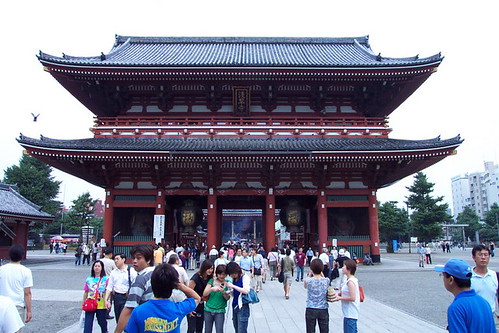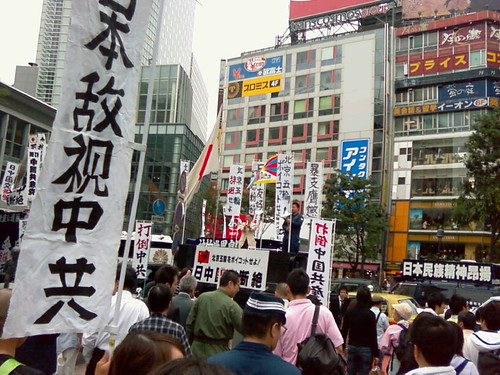
por rdesai
In order to enter the Old Tokyo will have to go to Asakusa station, where Sensoji is one of the oldest temples in Japan, visited by more than 20 million people per year. The spectacular complex, which dates from 632 and where they worship the goddess Kannon, also has a beautiful five-story pagoda. In terms of access, there is a market with many stalls, where you will find all sorts of traditional souvenirs, such as hachimachi (handkerchiefs to tie in the front) and variety of yukata, summer kimono’s frescoes. Kappabashi Nearby is an area of bazaars and famous Japanese dishes cutlery.
The latest fashion statement Harakuru wanders, where in Omotesando Dori (dori means street) are installed the most recognized and prestigious labels of clothes and accessories from Japan and the rest of the world. The site, a favorite of young Tokyoites, unrepentant consumerism, complete with European air cafes with terraces where you can see on the runway the latest trends in European collections and the United States.
Special nocturnal Roppongi every night is encouraged in its great variety of restaurants, bars, karaokes and discos, some open until dawn. It is the site chosen by young people for a drink at the bar or to eat. During the day the picture is another, especially in the area of Roppongi Hills, where you will discover the tallest buildings in the city: Tokyo Tower, which mimics the Eiffel Tower in Paris, the Mid Town, where you get to see the Mount Fuji, and Mori, who holds the prestigious Museum of Modern Art.
To have a real dimension of what is a megalopolis must pass through Shinjuku, Tokyo’s main station and the largest in Japan and the planet, where two million people circulate daily. There it joins with the Shinko, the bullet train, Japanese pride and something like an underground city, with more electronics and food business, its interior streets have direct access to office buildings and department stores in the area, providing one of the most contrasting views of the city, with streets of days gone under the bridge over the modern train, and behind a cluster of skyscrapers.
And there is still much to learn. You have to walk around Shibuya and famous crossroads, where a human tide waits for the lights to change behind a landscape full of colorful buildings with flashing ads and giant LCD screens. At dusk, the landscape seems to ignite a fireworks poster in one of its most representative of Tokyo today.

por j0hn.jp
Safety pins:
The tea ceremony. In some hotels, especially those with more stars, you can participate in step by step of this symbol of Japanese culture.
The Onsen. Share the traditional thermal baths community, in large pools, it is quite an experience. There are men and women, and mixed.
The ryokan. Stop living in the Japanese style, are these hotels, with the whole tradition of the country. Usually cared for by their owners in a world of kimonos, tatami mats and futons, offering traditional cuisine of the family, and even an onsen to relax after a walk.
Useful Information:
Tokyo metropolis is a safe, orderly and. .. Sparkling. Impossible to see a cigarette butt on the sidewalk, smoking is prohibited walking down the street, do it in places with ashtrays. The people are very friendly, always willing to help the visitor, and except for its urban layout with streets and alleys that crisscross, some ups and downs, nothing is complicated with a map in hand.
Very good free guide Metropolis, which provide hotels. Although reputed to be very expensive, you can eat and sleep for prices well off. For sure it has the world’s most expensive restaurant, covered 1,000 euros, and luxurious six-star hotels, but it is easy to find charming villas where one can stay from $ 60 a day with breakfast, and eat at any Japanese cuisine restaurant or a European average of U.S. $ 12 with a glass of French wine. Tipping is not customary.
Where prices soar is in transport. A fifteen-minute journey by taxi, spotless, with GPS and white-gloved driver, costs about $ 30, and the cheapest in the underground passage, 160 yen, that is $ 1.60. The entrances to museums and temples between 10 and 15 dollars.
Yokohama and Kamakura:
Take the bullet train and meet Kyoto is part of a traditional package to meet Japan. But if not enough time, a visit to Yokohama is a good option to leave town for a few hours. Tokyoites preferred site on weekends, the most important port in the country, evoking the Second World War, is now a stunning city with its own profile.
The Landmark Tower, the highest in Japan, overlooking the bay and offers its base in Queen’s Square, a shopping promenade with many shops and Mirato Mirai 21, very modern complex with the bottom of the Yokohama Bay Bridge, along to the great seaport, with larger vessels. Nearby is the colorful Chinatown, the most important settlement of the Chinese community in the country, a place for lunch in some of the restaurants or places to step, with its typical food, after going through streets full of shops with plenty of offers of all kinds.
From here the train will bring them closer to Kamakura, captive to a world view of churches and oratories in the quiet of the beautiful parks in the area. The nearest Train Station is the Shinto shrine of Tsurugaoka Hachimangu, traditional pilgrimage center of the Japanese where weddings and baptisms with ancient rituals.
From the vast expanse of access has a stunning view of the complex, the crowd gathered there given, before touring other temples and reach the Great Buddha of Kamakura. Materialized in bronze and 11 meters, the venerated statue awaits visitors struggled after a promotion to its site.

Until our virtual tour of the old Tokyo…
Leave a Reply
You must be logged in to post a comment.
Recent Comments